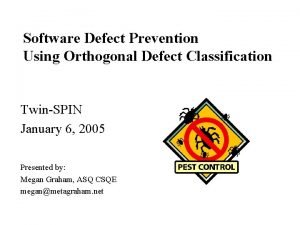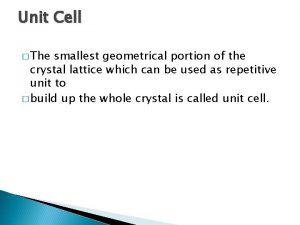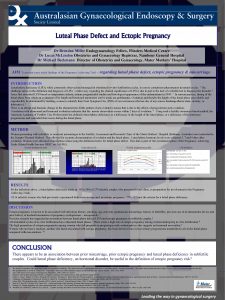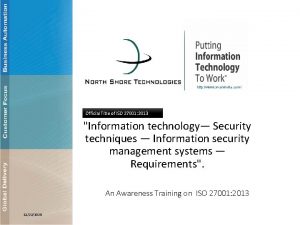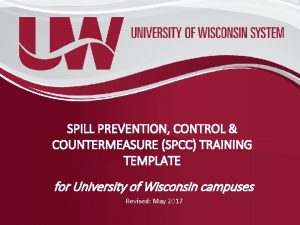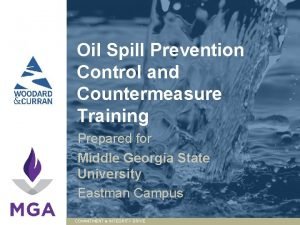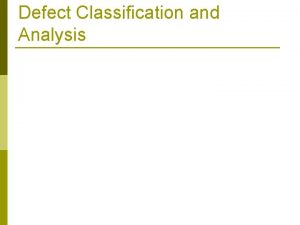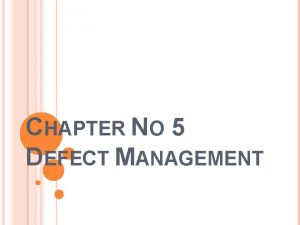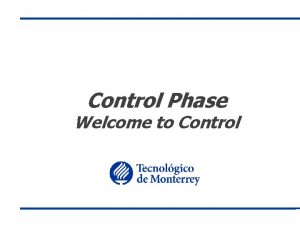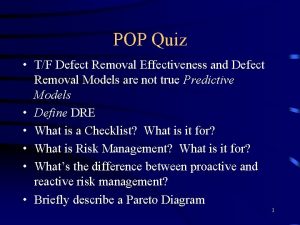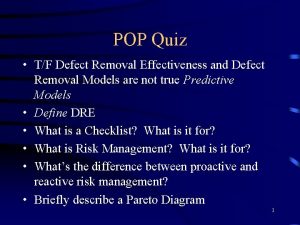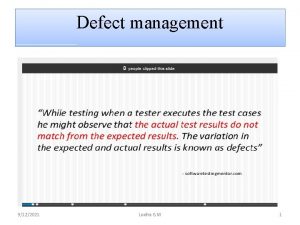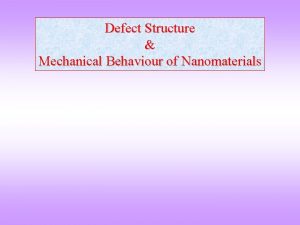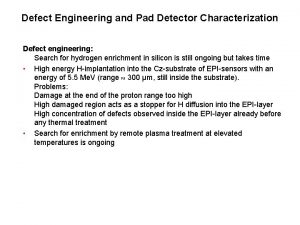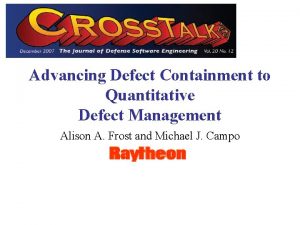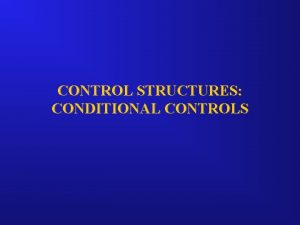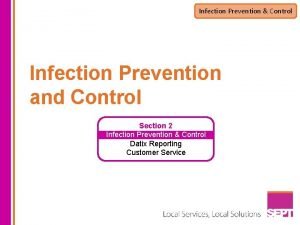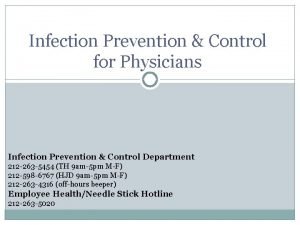Control Phase Defect Prevention Defect Controls Welcome to

























- Slides: 25

Control Phase Defect Prevention

Defect Controls Welcome to Control Lean Controls Realistic Tolerance and Six Sigma Design Defect Controls Process Automation or Interruption Six Sigma Control Plans Poka-Yoke Wrap Up & Action Items 2

Purpose of Defect Prevention in Control Phase Process improvement efforts often falter during implementation of new operating methods learned in the Analyze Phase. Sustainable improvements can not be achieved without control tactics to guarantee permanency. Defect Prevention seeks to gain permanency by eliminating or rigidly defining human intervention in a process. Yes sir, we are in CONTROL! 3

Level for Project Sustaining in Control 5 -6 : Six Sigma product and/or process design eliminates an error condition OR an automated system monitors the process and automatically adjust critical X’s to correct settings without human intervention to sustain process improvements BEST 4 -5 : Automated mechanism shuts down the process and prevents further operation until a required action is performed 3 -5 : Mistake proofing prevents a product/service from passing onto the next step 3 -4 : SPC on X’s with the special causes are identified and acted upon by fully trained operators and staff who adhere to the rules 2 -4 : SPC on Y’s 1 -3 : Development of SOPs and process audits 0 -1 : Training and awareness WORST 4

6 Product/Process Design Specification on Y Designing products and processes such that the output Y meets or exceeds the target capability. 24 22 Distribution of Y 21 19 Relationship Y = F(x) 17 10 11 12 13 14 15 16 17 18 19 20 Distribution of X When designing the part or process, specifications on X are set such that the target capability on Y is achieved. Both the target and tolerance of the X must be addressed in the spec limits. 5

Product/Process Design Upper Prediction Interval Specification on Y 24 22 Distribution of Y Relationship Y = F(x) 21 19 17 10 11 12 13 14 15 16 17 18 19 20 Distribution of X Lower Prediction Interval If the relationship between X and Y is empirically developed through Regressions or DOE’s uncertainty exists. As a result, confidence intervals should be used when establishing the specifications for X. 6

Product/Process Design Example Using 95% prediction bands within MINITABTM Stat > Regression>Fitted Lin Plot …. . Options…Display Prediction Interval Regression Plot Y = 7. 75434 + 5. 81104 X Generate your own Data Set(s) and experiment with this MINITABTM function. R-Sq = 88. 0 % 90 80 70 Output 60 What are the spec limits for the output? 50 40 30 20 Regression 10 95% PI 0 0 5 10 Input What is the tolerance range for the input? If you want 6 performance, you will remember to tighten the output’s specification to select the tolerance range of the input. 7

Product/Process Design Example Note: High output spec connects with top line in both cases. Lower input spec 8

Poor Regression Impacting Tolerancing Poor Correlation does not allow for tighter tolerancing. 9

5 – 6 Full Automation: Systems that monitor the process and automatically adjust Critical X’s to correct settings. • Automatic gauging and system adjustments • Automatic detection and system activation systems - landing gear extension based on aircraft speed and power setting • Systems that count cycles and automatically make adjustments based on an optimum number of cycles • Automated temperature controllers for controlling heating and cooling systems • Anti-Lock braking systems • Automatic welder control units for volts, amps and distance traveled on each weld cycle 10

Full Automation Example A Black Belt is working on controlling rust on machined surfaces of brake rotors: – A rust inhibiter is applied during the wash cycle after final machining is completed – Concentration of the inhibiter in the wash tank is a Critical X that must be maintained – The previous system was a standard S. O. P. requiring a process technician to audit and add the inhibiter manually As part of the Control Phase, the team has implemented an automatic check and replenish system on the washer. Full Automation Don’t worry boss, it’s automated!! 11

4 – 5 Process Interruption: Mechanism installed that shuts down the process and prevents further operation until a required action is preformed: • Ground fault circuit breakers • Child proof caps on medications • Software routines to prevent undesirable commands • Safety interlocks on equipment such as light curtains, dual palm buttons, ram blocks • Transfer system guides or fixtures that prevent over or undersized parts from proceeding • Temperature conveyor interlocks on ovens • Missing component detection that stops the process when triggered 12

4 – 5 Process Interruption Example: • • A Black Belt is working on launching a new electric drive unit on a transfer system – One common failure mode of the system is a bearing failure on the main motor shaft – It was determined that a high press fit at bearing installation was causing these failures – The root cause of the problem turned out to be undersized bearings from the supplier Until the supplier could be brought into control or replaced, the team implemented a press load monitor at the bearing press with a indicator – If the monitor detects a press load higher than the set point, it shuts down the press and will not allow the unit to be removed from press until an interlock key is turned and the ram reset in the manual mode – Only the line lead person and the supervisor have keys to the interlock – The non-conforming part is automatically marked with red dye Process Interruption 13

3 – 5 Mistake Proofing is best defined as: – Using wisdom, ingenuity, or serendipity to create devices allowing a 100% defect free step 100% of the time Poka-Yoke is the Japanese term for mistake proofing or to avoid “yokeuro” inadvertent errors “poka”. See if you can find the Poka. Yokes! 14

Traditional Quality vs. Mistake Proofing Traditional Inspection Result Worker or Machine Error Discover Error Don’t Do Anything Take Action/ Feedback Defective No Defect Sort At Other Step Next Step Source Inspection “KEEP ERRORS FROM TURNING INTO DEFECTS” 15

Styles of Mistake Proofing There are 2 states of a defect which are addressed with mistake proofing. ERROR ABOUT TO OCCUR ERROR HAS OCCURRED DEFECT ABOUT TO OCCUR (Prediction) DEFECT HAS OCCURRED (Detection) WARNING SIGNAL CONTROL / FEEDBACK SHUTDOWN (Stop Operation) 16

Mistake Proofing Devices Design Hints to help design a mistake proofing device: – – – BEST Simple Inexpensive Give prompt feedback Give prompt action (prevention) Focused application Have the right people’s input . . . makes it impossible for errors to occur BETTER ……allows for detection while error is being made GOOD . . . detects defect before it continues to the next operation 17

Types of Mistake Proof Devices Contact Method – Physical or energy contact with product • Limit switches • Photo-electric beams Fixed Value Method – Number of parts to be attached/assembled etc. are constant – Number of steps done in operation • Limit switches Motion-step Method – Checks for correct sequencing – Checks for correct timing • Photo-electric switches and timers 1 Guide Pins of Different Sizes 2 Error Detection and Alarms 3 Limit Switches 4 Counters 5 Checklists 18

Mistake Proofing Examples Everyday examples of mistake-proofing: • Home – – • • Automated shutoffs on electric coffee pots Ground fault circuit breakers for bathroom in or outside electric circuits – Pilotless gas ranges and hot water heaters – Child proof caps on medications – Butane lighters with safety button • • Computers – Mouse insertion – USB cable connection – Battery insertion – Power save feature Automobile – Seat belts – Air bags – Car engine warning lights Office – Spell check in word processing software – Questioning “Do you want to delete” after depressing the “Delete” button on your computer Factory – • Dual palm buttons and other guards on machinery Retail – Tamper proof packaging 19

Advantages of Mistake Proofing as A Control Method Mistake Proofing advantages include: – Only simple training programs are required – Inspection operations are eliminated and the process is simplified – Relieves operators from repetitive tasks of typical visual inspection – Promotes creativity and value adding activities – Results in defect free work – Requires immediate action when problems arise – Provides 100% inspection internal to the operation The best resource for pictorial examples of Mistake Proofing is: Poka-Yoke: Improving Product Quality by Preventing Defects. Overview by Hiroyuki Hirano. Productivity Press, 1988. ) 20

Defect Prevention Culture and Good Control Plans Involve everyone in Defect Prevention: – Establish Process Capability through SPC – Establish and adhere to standard procedures – Make daily improvements – Invent Mistake-proofing devices Make immediate feedback and action part of culture Don’t just stop at one mistake proofing device per product Defect Prevention is needed for all potential defects Defect Prevention implemented MUST be documented in your living FMEA for the process/product 21

Class Exercise Take a look around your work area or office to see what things you can identify as mistake proofed. Talk with your fellow workers about: – How was the need for the control system identified? – If a Critical X is mistake proofed, how was it identified as being critical? – How are they maintained? – How are they verified as working properly? – Are they ever disabled? Look for other areas where such beneficial things could be applied. 22

Class Exercise about Defect Prevention Prepare a probable Defect Prevention method to apply to your project. List any potential barriers to implementation. 23

Summary At this point, you should be able to: • Describe some methods of Defect Prevention • Understand how these techniques can help with project sustainability: – Including reducing those outliers as seen in the Advanced Process Capability section – If the vital X was identified, prevent the cause of defective Y • Understand what tools must document the Defect Prevention created in the Control Phase 24

The Certified Lean Six Sigma Yellow Belt Assessment The Certified Lean Six Sigma Yellow Belt (CLSSYB) tests are useful for assessing a Yellow Belt’s knowledge of Lean Six Sigma. The CLSSYB can be used in preparation for the ASQ or IASSC Certified Six Sigma Yellow Belt exam or for any number of other certifications, including private company certifications. The Lean Six Sigma Yellow Belt Course Manual Open Source Six Sigma Course Manuals are professionally designed and formatted manuals used by Belt’s during training and for reference guides afterwards. The OSSS manuals complement the OSSS Training Materials and consist of slide content, instructional notes data sets and templates. Get the latest products at… www. opensourcesixsigma. com 25 Advertisement
 Primary prevention secondary prevention tertiary prevention
Primary prevention secondary prevention tertiary prevention General controls vs application controls
General controls vs application controls He who controls the past controls the future
He who controls the past controls the future Defect prevention
Defect prevention Distinguish between schottky and frenkel defect
Distinguish between schottky and frenkel defect Kroger vink notation examples
Kroger vink notation examples Vacancy defect and interstitial defect
Vacancy defect and interstitial defect Luteal phase defect
Luteal phase defect Environmental controls infection control
Environmental controls infection control Iso 27001 domains, control objectives and controls
Iso 27001 domains, control objectives and controls Normal phase vs reverse phase chromatography
Normal phase vs reverse phase chromatography Hplc reverse phase vs normal phase
Hplc reverse phase vs normal phase Mobile phase and stationary phase
Mobile phase and stationary phase Hplc definition
Hplc definition Normal phase vs reverse phase chromatography
Normal phase vs reverse phase chromatography Phase to phase voltage
Phase to phase voltage Which detector used in hplc
Which detector used in hplc In a ∆-connected source feeding a y-connected load
In a ∆-connected source feeding a y-connected load Broad phase vs narrow phase
Broad phase vs narrow phase Spill response steps
Spill response steps Dfpc jprs
Dfpc jprs Chapter 26 infectious disease prevention and control
Chapter 26 infectious disease prevention and control Spill prevention control & countermeasures training
Spill prevention control & countermeasures training European centre for disease prevention and control
European centre for disease prevention and control Chapter 16 infection prevention and control
Chapter 16 infection prevention and control Prevention and control of poliomyelitis
Prevention and control of poliomyelitis



